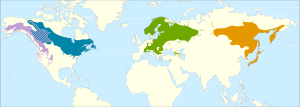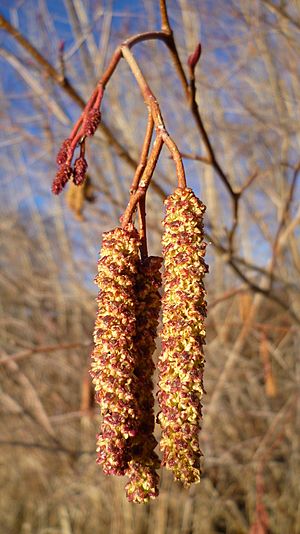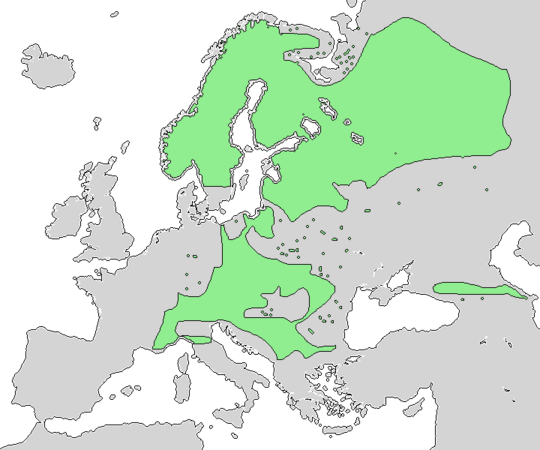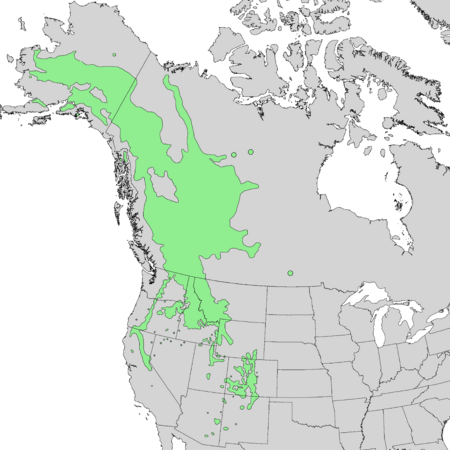Grey alder facts for kids
Quick facts for kids Grey alder |
|
|---|---|
 |
|
| Leaves of speckled alder | |
| Conservation status | |
| Scientific classification | |
| Genus: |
Alnus
|
| Species: |
incana
|
 |
|
| Range map | |
The grey alder or speckled alder (scientific name: Alnus incana) is a type of tree or large shrub. It belongs to the birch family. You can find it in many cool parts of the Northern Hemisphere, like Europe, Asia, and North America. This tree can grow in wet places, such as swamps and wetlands, and can spread slowly using underground stems called runners. You can often spot it by its small cones, bark that looks speckled, and wide leaves.
Contents
What Does the Grey Alder Look Like?
The grey alder is a small to medium-sized tree. It usually grows about 15 to 20 meters (50 to 65 feet) tall. Even when it's old, its bark stays smooth and grey. These trees live for about 60 to 100 years.
Its leaves are a dull green color and shaped like an oval. They are usually 5 to 11 centimeters (2 to 4 inches) long and 4 to 8 centimeters (1.5 to 3 inches) wide.
The flowers of the grey alder are called catkins. They appear early in spring, even before the leaves grow. The male catkins hang down and are 5 to 10 centimeters (2 to 4 inches) long. The female catkins are smaller, about 1.5 centimeters (0.6 inches) long, and grow to about 1 centimeter (0.4 inches) wide by late autumn.
The seeds are tiny, only 1 to 2 millimeters (about 0.04 to 0.08 inches) long. They are light brown and have a thin wing around them, which helps them fly in the wind. The grey alder has roots that don't go very deep. It can grow new shoots from its stump and also from its roots, especially in colder northern areas. The wood of the grey alder is similar to the black alder but is lighter in color and not used much for building or other products.
Different Types of Grey Alder
There are several different types, or subspecies, of the grey alder. Some scientists even think some of these are separate species. Here are a few of them:
- Alnus incana subsp. incana: This is the main grey alder found in northern Europe, northwestern Asia, and in mountains of central and southern Europe (like the Alps).
- Alnus incana subsp. hirsuta: Also known as the Manchurian alder, it grows in the mountains of Northeast and Central Asia.
- Alnus incana subsp. kolaensis: This type is found in the subarctic parts of northeast Europe.
- Alnus incana subsp. oblongifolia: Called the Arizona alder, it lives in the "sky islands" (mountain ranges) of the southwestern United States and northwestern Mexico.
- Alnus incana subsp. rugosa: Known as the speckled alder, it covers much of Canada (below the tree line) and the northeastern United States.
- Alnus incana subsp. tenuifolia: This is the mountain alder or thinleaf alder. It grows in western North America, from New Mexico to California and Alaska. Its roots have special bumps called nodules that help the plant get nitrogen from the air.
Where Grey Alders Grow and Live
The grey alder loves sunlight and grows quickly, even in poor soil. In central Europe, it often grows along mountain streams and rivers, up to 1,500 meters (about 4,900 feet) high. However, it doesn't always need wet soil; it can also grow on rocky slopes. In colder northern areas, it's a common tree in forests, old fields, and near lakes, even at sea level.
Many types of Lepidoptera (like butterflies and moths) use the grey alder as a food source for their caterpillars. In the large northern forests of Canada, the grey alder often grows with black spruce trees. Sometimes, the larvae of a type of sawfly called the alder woolly sawfly can eat a lot of the grey alder's leaves.
The speckled alder (A. rugosa) provides shelter for wild animals. Deer and moose eat its leaves and twigs, and birds enjoy its seeds.
How People Use Grey Alders
People plant grey alders in parks and gardens because they look nice. There's a special type called 'Aurea' that has green-gold leaves, and it has won an award for being a great garden plant.
This tree is also used to plant new forests or in a farming method called agroforestry. It's especially good for soils that aren't very fertile or are wet. This is because the grey alder has special bacteria in its roots that help add nitrogen to the soil, making it richer for other plants.
Alder trees are excellent for a practice called coppicing or pollarding. This means cutting the branches regularly to encourage new growth. The cut branches can be fed to animals like cows and goats. Then, the wood can be used for starting fires, as firewood, or for light building projects. Meanwhile, the roots continue to make the nearby farm soil better by adding nitrogen.
The Zuni people, a Native American tribe, use the bark of the tenuifolia subspecies to dye deerskin a reddish-brown color. The Ho-Chunk people, another Native American tribe, eat the bark of the rugosa subspecies when they have an upset stomach.
The wood and bark of the grey alder are also used to smoke meat, especially fish and duck, giving them a unique flavor.
See also
 In Spanish: Aliso gris para niños
In Spanish: Aliso gris para niños






